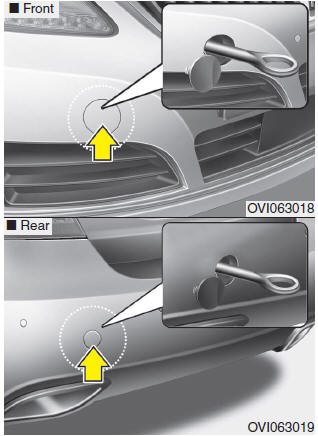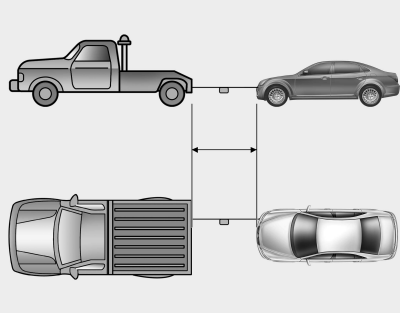 Hyundai Equus: Emergency towing
Second generation VI (2009–2025) / Hyundai Equus 2009-2025 Owners Manual / What to do in an emergency / Towing / Emergency towing
Hyundai Equus: Emergency towing
Second generation VI (2009–2025) / Hyundai Equus 2009-2025 Owners Manual / What to do in an emergency / Towing / Emergency towing

If towing is necessary, we recommend you to have it done by an authorized EQUUS dealer or a commercial tow truck service.
If towing service is not available in an emergency, your vehicle may be temporarily towed using a cable or chain secured to the emergency towing hook under the front (or rear) of the vehicle. Use extreme caution when towing the vehicle. A driver must be in the vehicle to steer it and operate the brakes.
Towing in this manner may be done only on hard-surfaced roads for a short distance and at low speeds.
Also, the wheels, axles, power train, steering and brakes must all be in good condition.
- Do not use the tow hooks to pull a vehicle out of mud, sand or other conditions from which the vehicle cannot be driven out under its own power.
- Avoid towing a vehicle heavier than the vehicle doing the towing.
- The drivers of both vehicles should communicate with each other frequently.
CAUTION
- Attach a towing strap to the tow hook.
- Using a portion of the vehicle other than the tow hooks for towing may damage the body of your vehicle.
- Use only a cable or chain specifically intended for use in towing vehicles. Securely fasten the cable or chain to the towing hook provided.
- Before emergency towing, check that the hook is not broken or damaged.
- Fasten the towing cable or chain securely to the hook.
- Do not jerk the hook. Apply steady and even force.
- To avoid damaging the hook, do not pull from the side or at a vertical angle. Always pull straight ahead.
WARNING
Use extreme caution when towing the vehicle.
- Avoid sudden starts or erratic driving maneuvers which would place excessive stress on the emergency towing hook and towing cable or chain. The hook and towing cable or chain may break and cause serious injury or damage.
- If the disabled vehicle cannot be moved, do not forcibly continue the towing. Contact an authorized EQUUS dealer or a commercial tow truck service for assistance.
- Tow the vehicle as straight ahead as possible.
- Keep away from the vehicle during towing.

- Use a towing strap less than 16 feet (5 m) long. Attach a white or red cloth (about 12 inches (30 cm) wide) in the middle of the strap for easy visibility.
- Drive carefully so that the towing strap is not loosened during towing.
✽ NOTICE
Emergency towing is not legal in all states. Contact an authorized EQUUS dealer and tow the vehicle.
Emergency towing precautions
- Place the transmission shift lever in N (Neutral).
- Release the parking brake.
- Press the brake pedal with more force than normal since you will have reduced brake performance.
- More steering effort will be required because the power steering system will be disabled.
- If you are driving down a long hill, the brakes may overheat and brake performance will be reduced. Stop often and let the brakes cool off.
CAUTION - Automatic transmission
- If the car is being towed with all four wheels on the ground, it can be towed only from the front. Be sure that the transmission is in neutral. Be sure the steering is unlocked by placing the Engine Start/Stop Button in the ACC position. A driver must be in the towed vehicle to operate the steering and brakes.
- To avoid serious damage to the automatic transmission, limit the vehicle speed to 10 mph (15 km/h) and drive less than 1 mile (1.5 km) when towing.
- Before towing, check the automatic transmission for fluid leaks under your vehicle. If the automatic transmission fluid is leaking, flatbed equipment or a towing dolly must be used.
 Removable towing hook (if equipped)
Removable towing hook (if equipped)
1.Open the trunk, and remove the towing hook from the tool case.
2.Remove the hole cover by pressing the lower part of the cover on the front
or rear bumper.
3.Install the towing hook by turning ...
 Maintenance
Maintenance
...
See also:
Schematic Diagrams
Circuit Diagram
...
Cylinder Block Components and Components Location
Components
1. Cylinder block bank cover2. Cylinder block bank cover gasket3. Cylinder block rear cover4. Cylinder block rear cover gasket5. Separator6. Drain plug7. O-ring8. Piston oil jet9. Chec ...
ESP Control Unit Components and Components Location
Components
[Standard]
1. Front-right tube2. Rear-left tube3. Rear-right tube4. Front-left tube5. MC26. MC17. ESP control module connector8. ESP control module(HECU)9. ESP HECU bracket
[Premiu ...
